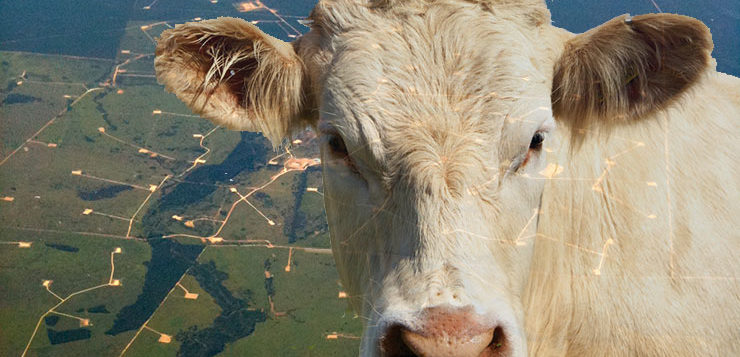The effects of coal seam gas mining on land and water are already well known. But what is it doing to our meat? Gemma Clarke reports.
When livestock producer Debbie Nulty went on local radio to discuss her fears about contamination in food-growing regions where coal and gas activities take place, she was met with apprehension. “I got a call from an industry representative,” she tells me. “He said, ‘Were you on the radio the other day? Do you realise what you’re saying could destroy an industry?’”
“You mean the gas industry?” I ask.
It’s a Tuesday night in Chinchilla, Queensland, and I’m sitting with Debbie in a function room at the local pub.
The venue has been booked by the Cameby Concerned Citizens Group, made up of people affected by coal seam gas (CSG) mining in South West Queensland. Debbie – who lives on a property in Australia’s South East – is there to discuss the potential risks to her livelihood posed by gas operations.
“No,” she replies, “the meat industry.”
Industry vs. Industry
It’s no secret that Australians are fond of their meat. The nation has been crowned one of the world’s meat-eating capitals, and munching on a servo pie is as iconic a part of Aussie culture as nabbing a sausage on a Sunday trip to Bunnings.
Our reputation for quality, disease-free meat also extends overseas. Grainfed Australian beef flies off supermarket shelves in Korea; McDonalds in the States boasts Australian beef in its Big Macs and Junior Burgers; queues form outside restaurants in Japan serving crumbed Australian beef cutlets.
Supplying over 100 markets globally, the beef industry contributes $18.4 billion to the GDP each year, and employs 438,100 Australians.
Another resource Australia has come to be renowned for is its reserves of conventional and unconventional gas – including coal seam gas (CSG) – which are used to provide power domestically and shipped internationally as liquefied natural gas (LNG).
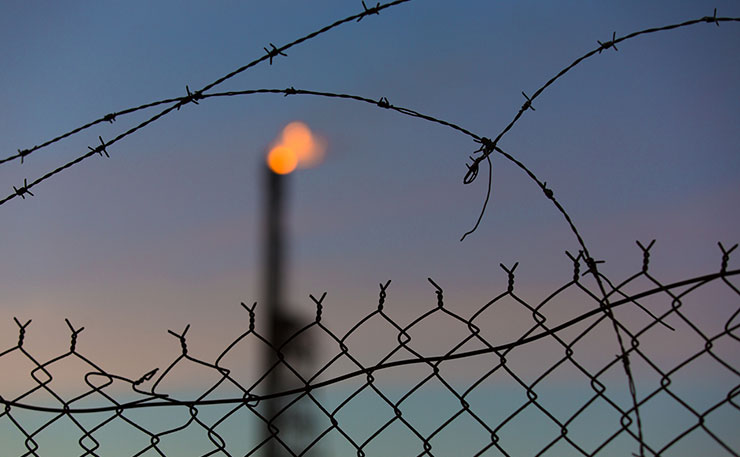
In the last financial year, Australia’s LNG export earnings were $31.7 billion, and are forecast to reach $48.4 billion in 2018/2019, making us the world’s biggest exporter.
Industry claims that the sector has created 100,000 jobs in Australia have been disputed; with 2015 figures showing 27,500 people are employed in oil and gas extraction full time.
How is CSG produced?
Since 1996, extensive CSG production has taken place in Australia, mainly in Queensland’s Surat and Bowen Basins. CSG is trapped underground by water pressure in complex geological systems. To access it, the coal seam is depressurised, which sees deep wells drilled and large volumes of groundwater pumped out.
Known as produced water, it tends to be high in salt and minerals, and can contain heavy metals and toxic compounds – some of which have been proven to be carcinogenic or even radioactive.
If the water and trapped gas don’t flow out freely, a technique known as “fraccing” is used, whereby a mixture of chemicals, sand and water are pumped into the coal seam to open up fractures to release the gas.
According to APPEA, the peak body representing Australia’s oil and gas industry, produced water has been thoroughly tested and is safe to use. In Queensland, beneficial use for irrigation, aquaculture, revegetation and stock activities is encouraged, though certain irrigation trials in NSW were determined to be “unsustainable” when the water left behind high levels of salt and heavy metals.
What are the impacts of CSG production?
Though the technological aspects of CSG activity are well documented, due to its relatively recent emergence, the health impacts are not fully understood, and “only a few limited studies” have been conducted.
Anecdotal evidence suggests there may be long-term health impacts on surrounding communities, and concerns abound that the chemicals involved could pollute water sources relied on in rural areas.
Research has also identified increased water salinity, destroyed agricultural land, reduced fauna and flora tolerance levels and erosion as potential risks.
Dale Stiller is a cattle farmer and landholder from Wandoan, north west of Brisbane in the Central Downs region. He said that even a small increase in salinity has a huge difference on a farm.
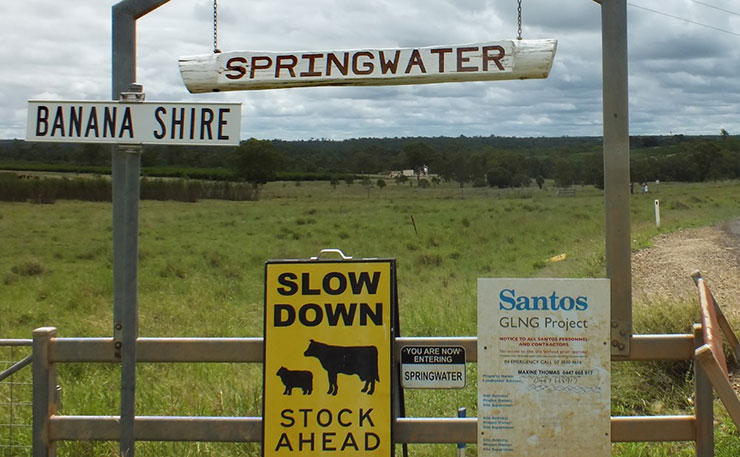
“Cattle can survive on so many parts per million salt, but that doesn’t mean they’ll thrive,” he said.
“You might end up with a replacement source of water that the cattle take another seven or 14 days to reach a peak condition for sale on.”
In September, approved plans to dump 15 million tonnes of salt and other CSG waste near a creek in Queensland were found to pose a “considerable” water contamination risk.
The proposed dump site is 20 kilometres from the state’s biggest environmental disaster, which saw Linc Energy penalised with record criminal fines for gas leaks amounting to “ecological vandalism”.
What testing is being done?
Across Australia, there are significant legal requirements to baseline test and monitor the quality of groundwater and aquifers likely to be impacted from resource operations.
A spokesperson from Queensland’s Department of Environmental Services said that CSG companies are also “generally required” to provide baseline data relating to soil, surface water and air.
But according to an anonymous Queensland feedlot operator, who has more than a dozen wells on his property, this is not always the case.
“We got none of that,” he said. “A lot of [the clauses in the contract]we didn’t agree with either.”
A cattle producer from Central Queensland who also wished to remain anonymous had a similar story.
The farmer told New Matilda that when he was first approached by the mining company that now has wells all over his property, “very few” clauses in the initial contract addressed his contamination concerns.
“They were meant to give us a full list of every chemical they were using [underground], but I wanted to know what was going to be used creek-side. We also wanted an independent weeds and seeds inspection done. They said no. Eventually, begrudgingly, they [agreed],” he said.
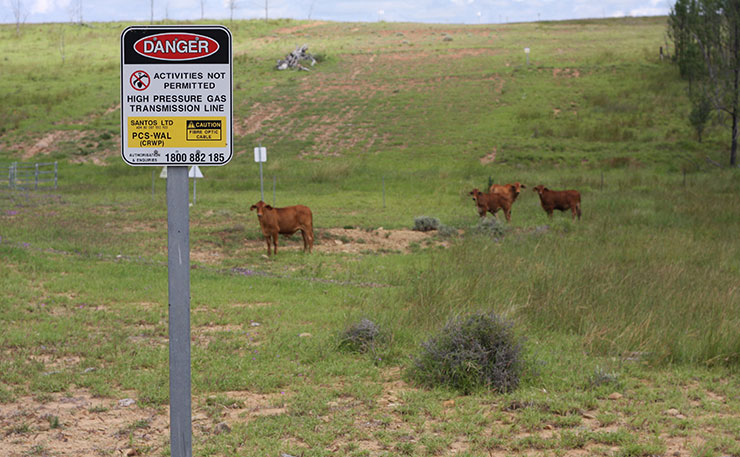
The mining company set a date for mediation with the farmer in the middle of harvest, giving two weeks’ notice.
“When it came time to sign the contract, everything we decided in the mediation was done away with. I wanted to know how they were going to keep their vehicles clean, keep weeds and seeds out, where everything was going.”
The farmer was informed that he had a fortnight to sign the contract, or he would have to go to land court.
“I work with an overdraft, so couldn’t go to land court,” he said. “That plays on your mind… you think, ‘If I don’t sit down and shut up, I’m going to lose everything.’”
Inadequate disclosure has also proven troublesome for Veronica Laffy, whose organic farm near Dalby is surrounded by CSG wells on all sides. The infrastructure is on neighbouring land rather than her own, so she has not been financially compensated.
“There’s never been any testing done on our creek water; there’s never been any baseline methane emissions testing done across the farm. One of the creeks comes from a lot of overland flow to the west of us, and all that country is covered in wells. What if they spill diesel?”
Veronica contacted the pollution hotline and the Department of Natural Resources requesting baseline data be taken before the well closest to her house became operational. Both government departments said that the requirements of the Environmental Act were being followed, and if she had any issues, to contact the companies directly.
“[The companies said] their landholder agreements are confidential and they don’t share that information. I wasn’t requesting landholder agreements; I was requesting information about the infrastructure.”
What about Australian beef?
The only beef testing that occurs for contaminants is part of the National Residue Survey (NRS), which sees carcasses tested on a randomised basis for a list of agricultural and veterinary chemicals.
A spokesperson for SAFEMEAT – the body responsible for protecting Australia’s red meat and livestock industry – said they continue to monitor scientific data relating to food safety issues, including contamination.
When asked exactly how this is achieved, it was explained that SAFEMEAT maintains a watching brief, which entails “monitor[ing]developments reported in scientific literature that become available in the public domain”.
“This typically involves periodic literature searches using specialised search engines, such as Google Scholar and CABI,” the spokesperson continued.
But is trawling the internet waiting for findings to be published if and when a contamination is discovered enough?
Dr Mariann Lloyd-Smith from the National Toxics Network called the fact we have so little monitoring data about the impact on farm animals and crops in Australia “an appalling state of affairs”.
“From evidence in the States, we’ve seen instances of neurological disorders, aborted pregnancy and stillborns. Obviously there is the potential to have an impact on farm animals,” she said.
The evidence she is referring to came from case reports published in 2012 and 2015 demonstrating livestock sensitivity to contaminants released by drilling and the cumulative impacts of exposure.
Health impacts decreased in animals when drilling activity decreased or when they moved from intensively drilled areas; when animals remained in affected areas, growth and respiratory problems increased.
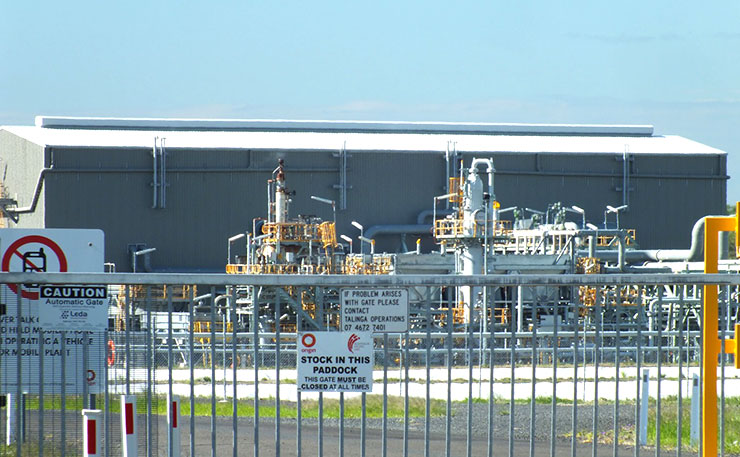
“If we have these bits of information,” Mariann continued, “it should have meant that, years ago, there would have been proper monitoring or assessment of potential risks and we’d have some real data to go on.”
Lee McNicholl, a cattle producer and veterinarian from Dulacca west of Miles, suggests an independent body come up with a list of contaminants used and released in CSG extraction that could have food safety implications.
“The industry should be made to disclose all chemicals they use, and have them assessed by the NRS to determine if they pose a threat and how best to test for them,” he said.
Exposure estimates in air pollution are often assessed using data from ambient air quality monitors, which offer limited coverage and temporal resolution.
In September this year, GISERA released a report into ambient air quality in the Surat Basin that stated the region’s air quality is typical of similar rural areas.
Page 22 discloses several challenges to measuring air quality, which caused “intermittent loss of data at Hopeland, Miles Airport and Condamine, and more significant loss of data at the Tara Region site”.
Despite this, APPEA Chief Executive Dr Malcolm Roberts called the report, “comprehensive” and “scientific”, and said that it “clearly dispels the claims that the gas industry is releasing toxic materials into the air”.
A spokesperson from Origin also voiced his approval of the findings.
GISERA is a collaboration between the CSIRO, governments and gas companies, which The Australia Institute says gives rise to a significant conflict of interest.
Declaring Meat Safety
When livestock are moved between properties, through saleyards and to processors, feedlots and the live export trade, producers fill in a detailed legal document: the Livestock Production Assurance National Vendor Declaration (LPA NVD).
Demanding evidence of livestock history and on-farm practices, the NVD seeks to preserve biosecurity and minimise exposure to sites and food potentially contaminated with chemicals.
Livestock producers and feedlot operators face legal ramifications if they fill one out incorrectly, or if a contamination incident is not first identified as a risk.
The document does not deal with potential contamination from CSG-industry-derived chemicals.
“We’re signing a food safety declaration saying our red meat is safe for consumption. If there’s a contamination or a residue incident, is the onus on us as livestock producers – will we be assumed perpetrators or victims?” Debbie asks.
According to SAFEMEAT, producers like Debbie are responsible for undertaking a property risk assessment to ensure they are aware of any potential areas of contamination, and are expected to take appropriate management steps to avoid the risks.
SAFEMEAT also recommends farmers get their own water testing carried out prior to the commencement of drilling for CSG on their property, at their own expense.
Many farmers say they lack the monetary resources to do so, and Shay Dougall, who relocated from her property at Hopeland when her home became surrounded by CSG projects, called it yet another arduous impact on landowners.
A Buried Investigation
In response to growing concerns held by farmers regarding liability, just over five years ago Meat and Livestock Australia (MLA) hired a legal firm to provide advice as part of a project initiated by the Cattle Council of Australia (CCA) and the Australian Feed Lot Association (AFLA).
This was to determine where producers and feedlot operators would sit if there was a CSG-related contamination. But when the firm completed its report, it announced it “should not be released”, claiming professional legal privilege.
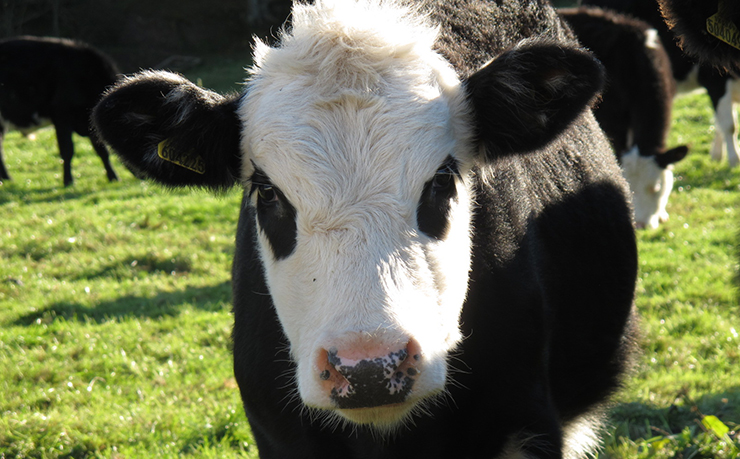
“If there are no problems, why not release the report?” asks Debbie. “It just seems so suspicious.”
At the time, AFLA told Beef Central it was disappointed in the outcome of the project, and CEO Dougal Gordon, who has since been replaced, said the summary provided to industry held little value due to it being so watered down.
Addressing Farmers’ Concerns
When approached for comment, a spokesperson from the Cattle Council said the issue was outside their scope, and suggested MLA be contacted instead. An MLA spokesperson claimed they do not handle policy and advocacy, and recommended approaching the Cattle Council and the National Farmers Federation (NFF).
Attempts to solicit further comment from the MLA were unsuccessful, as were attempts to contact the NFF.
The Department of Agriculture and Water Resources’ website claims they are concerned about contaminants that are a consequence of industrial activities.
When asked why they don’t test for CSG-related chemicals, they replied that no indication that meat produced from livestock in CSG areas poses a food safety or biosecurity concern has been received.
“There are no specific requirements for residue testing for CSG production,” a spokesperson said. “If there [are]concerns regarding food safety, this should be raised with Food Standards Australia New Zealand (FSANZ).”
When contacted, FSANZ claimed they are not an enforcement agency, and any questions should be directed to food enforcement authorities – such as the Department of Agriculture and Water Resources or Safe Food Production Queensland.
Safe Food Production Queensland was also unable to assist.
“Unfortunately, this matter does not fall under the remit of Safe Food Production Queensland,” was the reply.
“Too great a risk” to ignore
Dale concedes that Australian red meat may be perfectly fine, but we should not be ignoring the possibility of contamination.
“There’s a double-edged sword going on for cattle producers,” he says. “If we don’t do something about it, we [could]get hit with contamination. On the other hand, if you do talk about it, you get hit with people saying, ‘Oh, the beef’s unsafe!’
Once the Cameby Concerned Citizens Group meeting has finished, Debbie settles in the chair next to me.
“I’m tired, I want a rest,” she says, wiping tears from her eyes and suggesting she needs to watch a “good horse movie” before bed so that she doesn’t have nightmares.
“[Conventional and unconventional gas operations] shouldn’t be in food-growing regions. There’s no occupational health and safety for the farmers or their families. It will be consumers too who’ll pay the price.
“Agriculture and mining petroleum activities cannot possibly coexist.”
Donate To New Matilda
New Matilda is a small, independent media outlet. We survive through reader contributions, and never losing a lawsuit. If you got something from this article, giving something back helps us to continue speaking truth to power. Every little bit counts.

